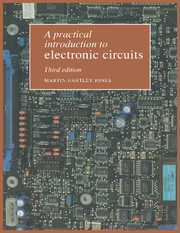Book contents
- Frontmatter
- Contents
- Preface to the third edition
- Preface to the second edition
- Preface to the first edition
- 1 Amplification and the transistor
- 2 The field-effect transistor
- 3 Thermionic valves and the cathode-ray tube
- 4 Negative feedback
- 5 Impedance matching
- 6 Semiconductor device characteristics
- 7 Amplification at high frequencies
- 8 Low-frequency signals, d.c. and the differential amplifier
- 9 Power supplies and power control
- 10 Pulse handling and time constants
- 11 Integrated circuit analogue building bricks
- 12 Positive feedback circuits and signal generators
- 13 Digital logic circuits
- 14 Microcomputer circuits and applications
- Appendix 1 Component identification
- Appendix 2 Transistor selection
- Appendix 3 Op amp data
- Appendix 4 Digital IC connections
- Appendix 5 Interfacing to the PC
- Bibliography
- Index
Preface to the first edition
Published online by Cambridge University Press: 05 June 2012
- Frontmatter
- Contents
- Preface to the third edition
- Preface to the second edition
- Preface to the first edition
- 1 Amplification and the transistor
- 2 The field-effect transistor
- 3 Thermionic valves and the cathode-ray tube
- 4 Negative feedback
- 5 Impedance matching
- 6 Semiconductor device characteristics
- 7 Amplification at high frequencies
- 8 Low-frequency signals, d.c. and the differential amplifier
- 9 Power supplies and power control
- 10 Pulse handling and time constants
- 11 Integrated circuit analogue building bricks
- 12 Positive feedback circuits and signal generators
- 13 Digital logic circuits
- 14 Microcomputer circuits and applications
- Appendix 1 Component identification
- Appendix 2 Transistor selection
- Appendix 3 Op amp data
- Appendix 4 Digital IC connections
- Appendix 5 Interfacing to the PC
- Bibliography
- Index
Summary
Anyone who is interested in technology is aware of the importance of electronics. Despite its all-pervading influence, however, electronics retains a strong element of mystery for many people who are otherwise well informed on technical matters. In this book, I aim to provide a practically-based explanation of the subject to try to dispel the mystery.
In the study of electronics, I have always found practical experience to be an invaluable stimulant and confidence-builder. There is enormous satisfaction in ‘lashing up’ a new circuit on the test bench and seeing it work for the first time. As an experimental physicist, I have never regarded electronic design as an end in itself, but rather as a valuable tool in research and development. The practical approach is therefore of primary importance in the electronics content of the UMIST Pure and Applied Physics degree course. Experience of teaching electronics to people of various backgrounds has encouraged me in the belief that a book based on a practical viewpoint can be valuable at all levels from school, through college or university, to the industrial laboratory. This book aims to cover a wide range of circuit building bricks, analogue and digital, discrete and integrated. It is from these bricks that an elaborate system is constructed, whether it be a colour television set or a computer. Sufficient practical information is given to enable the reader to construct the circuits and test them in the laboratory.
- Type
- Chapter
- Information
- A Practical Introduction to Electronic Circuits , pp. xxi - xxiiPublisher: Cambridge University PressPrint publication year: 1995



